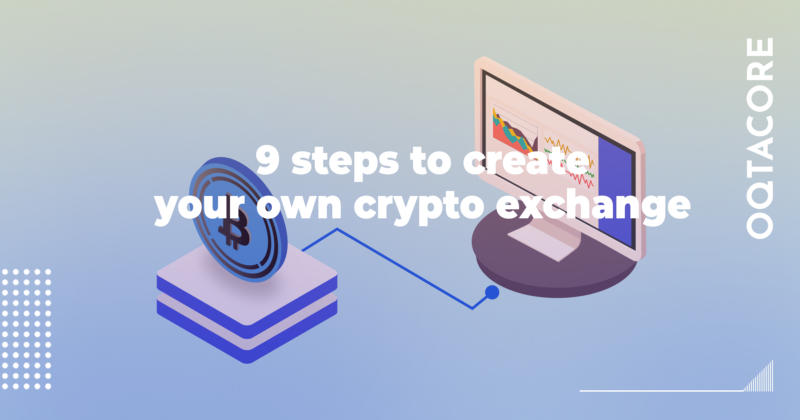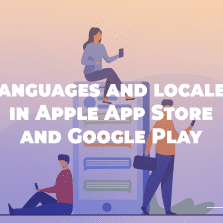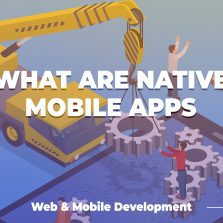

It seems that the crypto exchange market is already full, and the biggest players have been identified. Forbes estimates that there are currently 500+ cryptocurrency exchanges worldwide, with Binance, OKX, UPBit and Coinbase being the most popular by sales volume.
However, it’s not all good in the crypto market in 2022. FTX filed for bankruptcy and Genesis is already warning of bankruptcy without funding. Major players are slowly falling off, thereby creating more room in the market. This could play to your advantage if you create your own crypto exchange in 2022-2023.
OQTACORE has put together this guide to get you started. We will tell you what cryptocurrency exchanges are, how to develop your own and how to launch it successfully.
What is a cryptocurrency exchange?
A cryptocurrency exchange is an online platform where you can buy and sell cryptocurrency. You can exchange from one cryptocurrency to another, like Ether to Dogecoin, or from cryptocurrency to fiat money, like the US dollar. Crypto exchanges store users’ assets and allow them to withdraw them to bank accounts and crypto/electronic wallets. Exchanges also show the exchange rates of available currencies and analyze market statistics, cryptocurrency sales volume and so on.
Because of the features described above, crypto exchanges must be transparent and very secure, fast and user-friendly, with understandable analytical tools.
So, we’ve provided you with the definition and explained the general principles of work. Now we’ll tell you how to create your own exchange step by step.
Step 1: Choose the crypto exchange type
From here you will better understand how and with what tools to develop an exchange. There are 3 types of exchanges in total.
Centralized exchange (CEX)
CEX act as direct intermediaries between buyers and sellers of digital assets (hence “centralized”). Such exchanges are essentially similar to banks: users trust them with their assets and trust that transactions will be conducted safely.
Convenience is the main advantage of CEX, which makes it more popular among users. Top centralized exchanges usually have a user-friendly interface that allows fast trading and investing.
But this type of exchange has two problems. The first is security. Since users store cryptocurrency in the exchanges’ built-in wallets, hackers can get into them. Hackers took home $14 billion in cryptocurrency in 2021, and most of the attacks were in CEX. Unfortunately, there is no way to get rid of hacker attacks completely. Exchanges are constantly upgrading their security, but more often than not they just have to compensate for losses (most exchanges have folded up because they failed to do so).
The second problem of centralized exchanges is the inconsistency in the ethics of cryptocurrency decentralization. Most exchanges require the user to pass the Know Your Customer procedure, asking users for personal data when creating accounts. This contradicts the principles of anonymity in the cryptocurrency world.
Examples: Binance, Coinbase, Kraken, and others.
Decentralized exchange (DEX)
Unlike centralized ones, these exchanges provide direct trading between users’ crypto wallets, without being an intermediary. Technically, the intermediary is a program on a blockchain – a smart contract – which works automatically (check our previous article to find out where else smart contracts are used).
This type of exchange is popular for the fact that it doesn’t collect personal data and doesn’t require the user to pass the Know Your Customer process. Besides, since there are no intermediaries, the user almost does not risk anything, all transactions are transparent.
However, these exchanges also have shortcomings. In contrast to centralized exchanges, DEX are designed more for experienced investors than for newbies. The point is the complex interfaces and currency conversion methods. Decentralized exchanges don’t allow you to deposit fiat currency and exchange it for cryptocurrency. Users need to either already own it or buy it on DEX.
Another inconvenience is that users are involved in direct peer-to-peer transactions, meaning they have to find buyers themselves, which takes time.
Examples: Uniswap, PancakeSwap, Sushiswap and others
Hybrid exchange
The least common type so far. They combine DEX and CEX principles. Such exchanges store transactions and encrypt them on a blockchain but process them on a third-party centralized node.
Examples: Qurrex, Eidoo, Legolas.
Step 2. Get an understanding of your jurisdiction
Below is a small checklist of which legal aspects you should focus on in your country
- Whether registration of a cryptocurrency business and cryptocurrency circulation are allowed in your country;
- Whether you need a license for an exchange business and to collaborate with official payment systems and banks
- Peculiarities of corporate law — is having an office on the territory of the country required?
- Cost of services and equity capital requirements;
Step 3. Choose an architecture for the exchange
This will help you understand how the components of your exchange will work. But first, let’s look at the components or modules. Most exchanges include:
- Login, user authentication
- Connection of multiple wallets
- User interface
- Interface and trading engine (payments, accounting, and analytics)
- API
- Databases
Architecture is how these modules are located “under the hood” of the exchange. Depending on their connection and interaction, the exchange will differently load pages, process requests, and so on.
There are three main types of architectures:
Monolithic
Here, everything is simple: each of the above components resides on a single server. They can be developed faster, and deployment takes less time. However, this architecture limits functionality – one server will not be able to process thousands or millions of user requests. Conclusion: this architecture is suitable for low-cost projects.
Modular, or Microservice Architecture
Unlike the monolithic architecture, each component – login, interface, trading engine, etc. – resides on a separate server, which allows the exchange to withstand high loads. This is the most convenient architecture for both users and developers, but it requires more resources and time to create. Conclusion: suitable for medium projects.
Distributed
This is a more advanced version of the modular architecture. Each component of the exchange will have not one but several servers at once. For example, the trading engine is divided into payment acceptance, processing and analytics of all payments, and each of these “sub-modules” will have their own server. These exchanges are the most expensive, but also the most efficient. Conclusion: if you want to build an expensive “giant industry exchange”, then choose this architecture.
Step 4. Decide on a development method
There are two ways: developing from scratch and a white label or a ready-made solution.
To build from scratch, you will need an experienced team, huge investments, and a lot of time. And don’t forget to double-check the security and proper compliance of your product with the jurisdiction of the country it is intended for.
Buying an off-the-shelf solution will be faster and cheaper, but you’ll still need a separate development team to customize it. So, choose carefully. For convenience, you can right away buy a white-label product – an out-of-the-box solution produced by one company that another company rebrands to make it look as if they had made it.
Step 5. Select a tech stack
Now it’s time to choose your tools. OQTACORE and other professional developers use the following frameworks and programming languages
Web Frontend Development: React, Angular, Vue.js, Vanilla.js
Web Backend Development: C#, PHP, Django, Laravel
Web Database Solutions: MS SQL, SQLite, MongoDB
Android Mobile App: Swift, ObjectiveC
IOS Mobile App: Kotlin, Java
Mobile Database Solutions: CryptoSwift, SQLite, Shared Preferences, UserDefaults, CoreData
Step 6. Basic functionality
Authorization and verification. Verification is required by international rules to protect users from fraud, wallet attacks, and to prevent money laundering. However, authorization must not only comply with the rules, but also be convenient. This is not the easiest task, so carefully conduct your UX research
Linking e-wallets and credit/debit cards. Users should be able to link their own wallets and/or create them directly on your platform. It’s important to make either option secure and it should be able to facilitate fast conversion of fiat currencies and cryptocurrencies.
Trading engine. This is the backbone of your exchange. It is the engine that executes transactions, controls funds in users’ accounts, creates charts and conducts analytics on every offer and bid.
Dashboards and analytical tools. Users should have all the necessary information for trading –comparison and history of exchange rates. For daily flow of information, it is worth implementing an analytical panel with charts (you can add APIs from Coinlayer, CoinMarketCap, Crypto API, etc.), a notification system, a chat bot and a tech support service.
Admin panel. You need to keep track of user actions, how transactions are going, content status, and wallet security. The system should detect strange and dangerous actions automatically and warn admins about them. It’s also important to embed your own dashboard and analytical tools into the panel.
Step 7: Develop the design
In today’s world, every platform, including a cryptocurrency exchange should have a high-quality and carefully crafted UI/UX design. In our articles, you’ll learn about what the UX process consists of in modern business, and what the peculiarities of interface design for blockchain products are.
Step 8: Security
When designing a cryptocurrency exchange, always bear in mind that attackers are constantly trying to hack such exchanges.
We’ve prepared a list of the most common types of hacker attacks and ways to protect against them.
Hacking the admin panel
Tip #1: Add two-factor authentication via SMS, messengers or Google Authenticator
Tip #2: Don’t store user funds in the admin panel. Use hybrid cold storage through Ledger or Trezor wallets
User hacking
Tip #1: As in the first case, two-factor authentication is a great protection. The hacking typically begins with the user’s email.
Tip #2: Add features to track device authorization, location, session duration, and IP address. In this case, admins will be able to see suspicious user actions and ask the possible fraudster for additional authorization data.
Server hacking
Tip: Don’t skimp on your business Internet service provider; security is paramount. The most popular and reliable tool against DDoS attacks is Amazon Web Services. OQTACORE engineers often use it in their work.
Permit-based fraudulent process.
Tip: Carefully select the people you want to give admin rights to. Recall that you can create and assign the roles of moderator, admin, super-admin, etc. to work in the admin panel. Your employee could be a rogue himself or a collaborator.
Vulnerabilities through external systems or tools.
Tip: Choose reliable services. When building an exchange, you will have to use third-party services, such as payment gateways, authorization system integration in social networks, CRM system, and others. Each of them is a separate set of scripts and libraries that can also be hacked. Keep an eye on tools from your partners, always install updates, and limit the number of third-party services.
Step 9. Test the exchange
Below is another checklist from us – things that you need to double-check in your exchange:
- Know your Customer compliance check
- Testing the authorization and registration process;
- Testing cryptocurrency buying and selling;
- Vulnerability and OWASP testing
- API and WebSockets testing.
How much does it cost to develop an exchange?
Such a project would cost you $130-350K. . Below we have attached a table with our price for all required development team members:
| Product Strategist | $100/hr |
| Senior Backend Developer | $100/hr |
| Senior Frontend Developer | $100/hr |
| Blockchain Developer | $70/hr |
| Project Manager | $50/hr |
| UX/UI designer | $35/hr |
If you want to buy a crypto exchange white label or develop your own crypto exchange and you need an experienced development team, contact OQTACORE. Our Frontend and Backend Developers, UX/UI Designers, Product and Project Managers have launched 50+ MVPs in blockchain, web and mobile development, ecommerce and marketplace development. We’ve collaborated with Allianz, BMW, Burger King, Thomson Reuters and Western Digital. To schedule a call with our CTO, follow this link.






